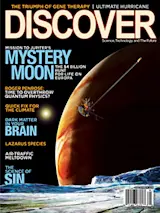The Science Channel show Brink
produced a segment based on this DISCOVER story; see the video below.
Image: NASA/JPL | NULL
Growing up on Long Island, Pappalardo was seduced by astronomy early. He began hanging planets from the ceiling of his bedroom at age 7. While studying at Cornell University in the mid-1980s, he sat in on a seminar with Carl Sagan and was enraptured by speculation of oceans on distant moons. As a researcher at Brown University in the late 1990s, Pappalardo worked on the Galileo mission when the first detailed pictures of the planet’s icy satellites were beamed back to Earth. Later he landed a job at the University of Colorado at Boulder before moving to JPL, the mecca of solar system exploration.
Pappalardo’s low-key, almost shy manner and science-casual style of dressing are deceptive. He is part of a savvy new breed of researchers who are as ...














